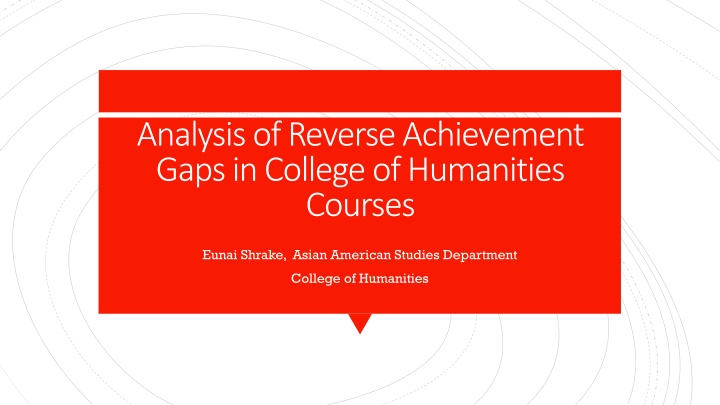
Promoting Student Success and Closing Achievement Gaps in College Humanities Courses
Conducted by Eunai Shrake from the Asian American Studies Department, this analysis focuses on reverse achievement gaps in College of Humanities courses at CSUN. It delves into factors contributing to these gaps, such as instructor diversity and course content, proposing solutions like hiring more URM faculty and expanding ethnic studies curriculum.
Download Presentation

Please find below an Image/Link to download the presentation.
The content on the website is provided AS IS for your information and personal use only. It may not be sold, licensed, or shared on other websites without obtaining consent from the author. If you encounter any issues during the download, it is possible that the publisher has removed the file from their server.
You are allowed to download the files provided on this website for personal or commercial use, subject to the condition that they are used lawfully. All files are the property of their respective owners.
The content on the website is provided AS IS for your information and personal use only. It may not be sold, licensed, or shared on other websites without obtaining consent from the author.
E N D
Presentation Transcript
Analysis of Reverse Achievement Gaps in College of Humanities Courses Eunai Shrake, Asian American Studies Department College of Humanities
Guiding Questions: 1. How can we promote student success among URM students at CSUN? 2. How can we close traditional achievement gaps between URM and Non-URM students? Guiding Questions Research Questions: 1. Are there reverse achievement gaps in CoH courses? 2. What are the factors that contribute to reverse achievement gaps in CoH courses?
Characteristics of CoH Courses with Reverse Achievement Gaps # of COH courses with .20 - .29 reverse gaps: 14 with over .30 reverse gaps: 13 # of sections of these courses: 86 Disciplines & Subject Areas of the Courses 1 AIS, 4 AAS, 3 CAS, 6 CHS, 2 ENGL, 2 LING, 4 MCLL, 2 PHIL, 3 RS Overview of Data Upper /Lower Division Courses: 16:11 Courses with reverse gaps 2 consecutive semesters CSU Student Success Dashboard & IR Data (Fa 2015-Sp 2017) AAS 113, AAS 340, CAS 100, CHS 445, LING 417, PHIL 344, PHIL 348, SPAN 102 Content Areas of the Courses Stretch Writing, Ethnic History, Ethnic Art, Ethnic Culture, Ethnic Philosophy, Ethnic Women, Ethnic Religions, Foreign Language, American Writers, Playwriting, Philosophy & Feminism
Within-College Factors of Reverse Achievement Gaps Subject-Areas: Ethnic/Area/Language Studies (AIS, AAS, CAS, CHS, LING, MCLL) tend to have more reverse gaps Specific Course Contents in Traditional (non-Ethnic studies) Disciplines: related to minority studies (e.g., Phil & Feminism, Chinese Phil, Islam, Asian Religious Texts, Ethnic Literature) Instructor Race: Out of 86 sections, 56 sections were taught by non-White instructors, indicating a high rate of Racial Match between Instructors and Enrolled Students Findings Student Racial Composition of the classes: More URM students Lower vs. Upper Division 11:16 (Lower division courses are multi-sectioned, having higher impact than upper division courses on URM students achievement ) GE Section F (Comparative Cultural Studies): 6 out of 16 (38%) Upper Division courses were GE section F
Consider hiring more URM faculty to promote student- instructor racial match Expand Ethnic/Area Studies Curriculum Reassess the validity of GE section F Concluding thoughts & Recommendation Provide Academic Advising (Major/Course Selection) at the Dept. Level Next steps: To understand why specific courses show reverse achievement gaps, more qualitative research to find contextual factors through course content analyses (syllabi analysis), classroom observation (pedagogy & classroom climate & learning environment), student interviews, etc.
